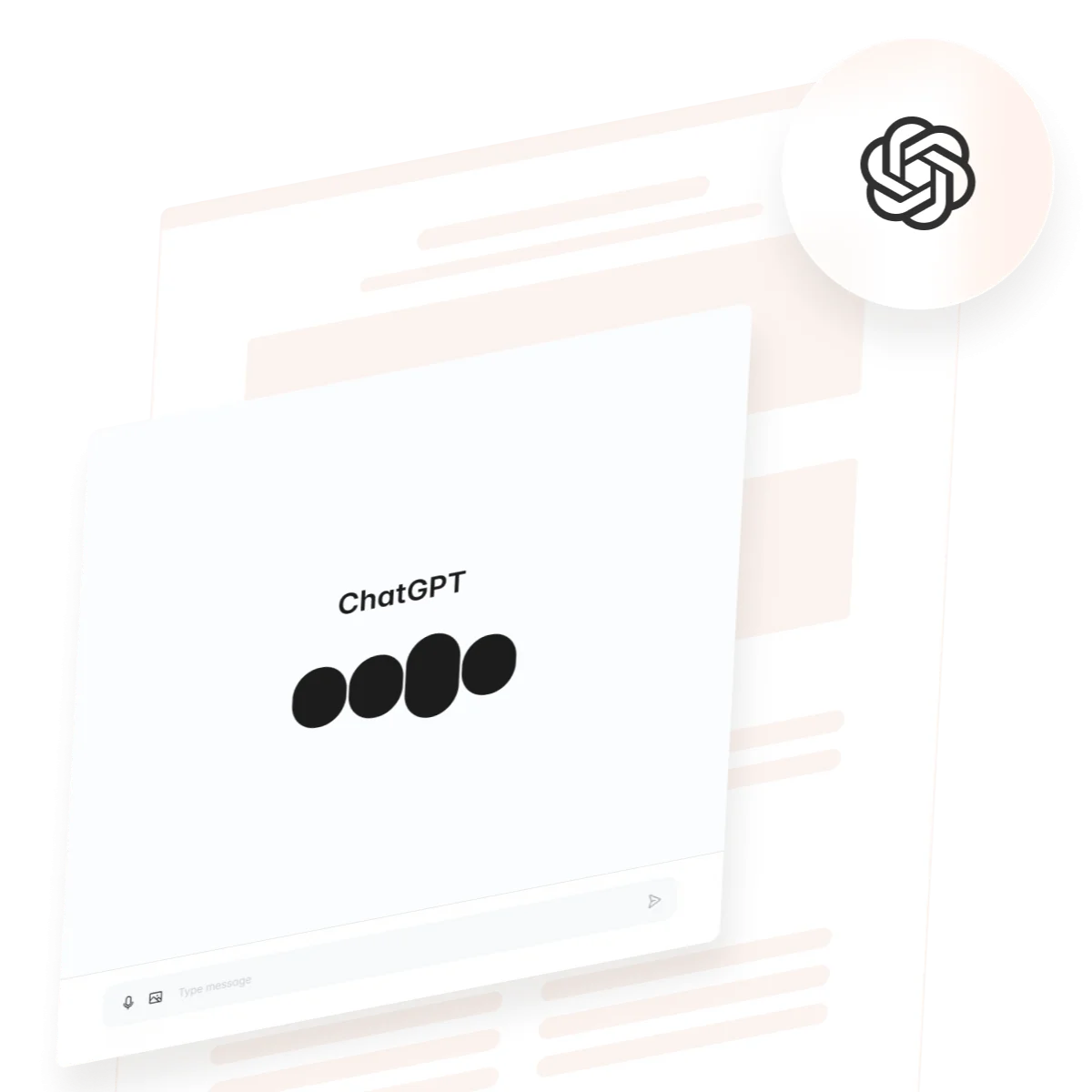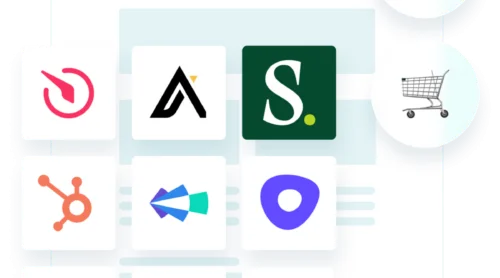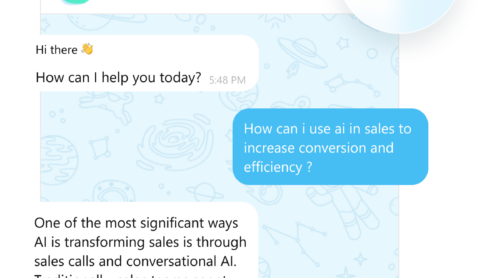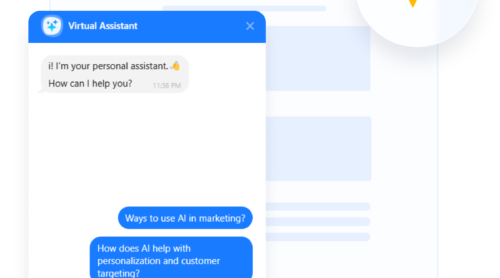ChatGPT is a powerful AI tool with the ability to generate responses across a wide range of topics. But can you train ChatGPT to meet your specific needs? The answer is yes! By training ChatGPT with your own data, you can tailor its responses to be more accurate and relevant to your business or project.
In this guide, we’ll dive into the best methods for training ChatGPT on your own data. We’ll compare these methods based on ease of use, flexibility, and technical expertise required. By the end, you’ll have a clear understanding of how to train ChatGPT to better suit your unique needs.
Why Train ChatGPT on Your Own Data
The default ChatGPT model is trained on a wide range of general knowledge, but it may not always provide the most accurate or relevant responses when it comes to specialized subjects. This is especially true for niche industries or highly specific use cases. While ChatGPT excels in general conversations, it may struggle with in-depth knowledge or technical language.
Some of the key benefits of training ChatGPT on your own data include:
- More Accurate and Relevant Responses. By feeding ChatGPT with specialized data, you make it more proficient in your subject area, reducing errors and irrelevant answers.
- Improved Performance in Specialized Industries. Whether you’re in healthcare, legal, education, or customer support, training ChatGPT with industry-specific data makes it capable of handling technical jargon and providing accurate insights that general models might miss.
- Better Alignment with Brand Voice and User Needs. By customizing its tone and the way it responds, you can ensure ChatGPT speaks in a way that resonates with your audience, making interactions feel more natural and consistent with your brand. This is particularly important if you’re building a customer-facing AI that represents your business.
- Faster and More Efficient Problem Solving. With customized training, ChatGPT can provide quicker, more accurate solutions to common inquiries or tasks relevant to your business, improving both user experience and efficiency.
In summary, training ChatGPT on your own data not only improves its accuracy but also boosts its ability to handle specific challenges, making it a more powerful and valuable tool for your unique requirements.
Comparing Methods for Training ChatGPT
Now that we understand the benefits of training ChatGPT on your own data, let’s dive into the three main methods for doing so. Each of these approaches offers different levels of customization, ease of use, technical requirements, and cost, which will influence your decision based on your specific needs and technical expertise.
Here’s a quick comparison of the three main methods for training ChatGPT with your own data:
| Method | Ease of Use | Customization Level | Technical Skill Required | Deployment Flexibility | Cost Considerations |
|---|---|---|---|---|---|
| OpenAI Custom GPT | High | Moderate | Low | Web-based | Requires ChatGPT Plus |
| Elfsight AI Chatbot | Very High | Moderate | None | Website integration | Free plan; paid plans from $5/month |
| OpenAI API | Low | High | High | Fully customizable | Pay-per-use pricing |
Key Factors to Consider:
- Ease of Use:
How easy is it to get started with the method? Some methods, like Elfsight AI Chatbot, are designed for users with little to no technical expertise, while others, like OpenAI API, require more advanced skills. - Customization Level:
How much control do you have over the model’s responses and behavior? For example, OpenAI API offers the highest level of customization, allowing full control over how the model learns and responds. - Technical Skill Required:
How much technical knowledge is needed? OpenAI Custom GPT is very beginner-friendly, while the API requires expertise in coding and API interactions. - Deployment Flexibility:
Where and how can you deploy the model once trained? Some methods are limited to web-based applications (e.g., OpenAI Custom GPT and Elfsight AI Chatbot), while the API allows for full integration into any platform. - Cost Considerations:
What is the pricing model for each method? Elfsight’s freemium model offers a free version, but some advanced features may require payment. OpenAI Custom GPT requires a subscription to ChatGPT Plus, while the API charges on a pay-per-use basis, which may be more expensive depending on usage.
Each method has its strengths and trade-offs. Your decision will depend on your technical abilities, the level of customization required, and your budget.
Using OpenAI’s Custom GPTs for Easy Training
OpenAI’s Custom GPTs offer an intuitive and user-friendly way to customize ChatGPT without needing any technical expertise. Available to ChatGPT Plus subscribers, this method allows you to create a tailored version of ChatGPT that can be trained with your specific data. It’s a great option for users who want a straightforward solution to fine-tune the model’s responses, making it more aligned with their business needs or personal preferences.
By using the Custom GPT feature, you can define how ChatGPT behaves, respond to specific queries, and adjust the tone and style of its responses — all without writing any code. This method strikes a balance between ease of use and customization, offering a quick and effective way to personalize ChatGPT.
Steps to Get Started:
- Subscribe to ChatGPT Plus. To begin using Custom GPTs, you first need to subscribe to ChatGPT Plus. This will give you access to the extra features, including the ability to create Custom GPTs.
- Access the “Explore GPTs” Section. Once you have the Plus subscription, log in to your ChatGPT account and navigate to the ‘Explore GPTs’ section located in the sidebar.
- Create a New Custom GPT and Set Instructions. Click on ‘Create a Custom GPT’ to start the process. You’ll be prompted to provide a name and description for your custom model. This is where you can set instructions, such as how you want the model to behave, what it should focus on, and the tone it should use when responding.
- Upload Relevant Data. Custom GPTs allow you to upload files (such as documents, guidelines, FAQs, product descriptions, or any other relevant data) that the model can reference when generating responses. You can upload these documents directly from your computer.
- Test and Refine Responses. After setting up your Custom GPT, test it by interacting with the chatbot. Enter different prompts and assess how well the responses match your desired outcomes. If necessary, refine the instructions, upload additional data, or adjust the tone to improve accuracy. You can continue testing and fine-tuning until the chatbot meets your needs.
Limitations:
- Subscription Requirement. To use Custom GPTs, you need a ChatGPT Plus subscription, which involves a recurring cost.
- Less Flexibility. While the Custom GPT offers a great level of customization, they still have limitations compared to more advanced methods, such as API fine-tuning. You cannot fine-tune the model as deeply or integrate it into highly specialized workflows.
Building a Custom AI Chatbot with Elfsight
Elfsight AI Chatbot offers a simple, no-code solution that allows you to integrate a fully functional assistant into your website. Whether you’re looking to provide customer support, answer frequently asked questions, or improve user engagement, Elfsight enables you to quickly set up and customize a chatbot tailored to your needs.
With its intuitive interface, you can customize the chatbot’s responses and design without needing any coding experience, making it ideal for businesses that want a quick solution with minimal effort.
The platform also allows you to upload data like FAQs, product info, and documents, which the chatbot uses to generate more relevant responses. This solution works best for businesses looking for a user-friendly way to add intelligent chatbot functionality to their website.
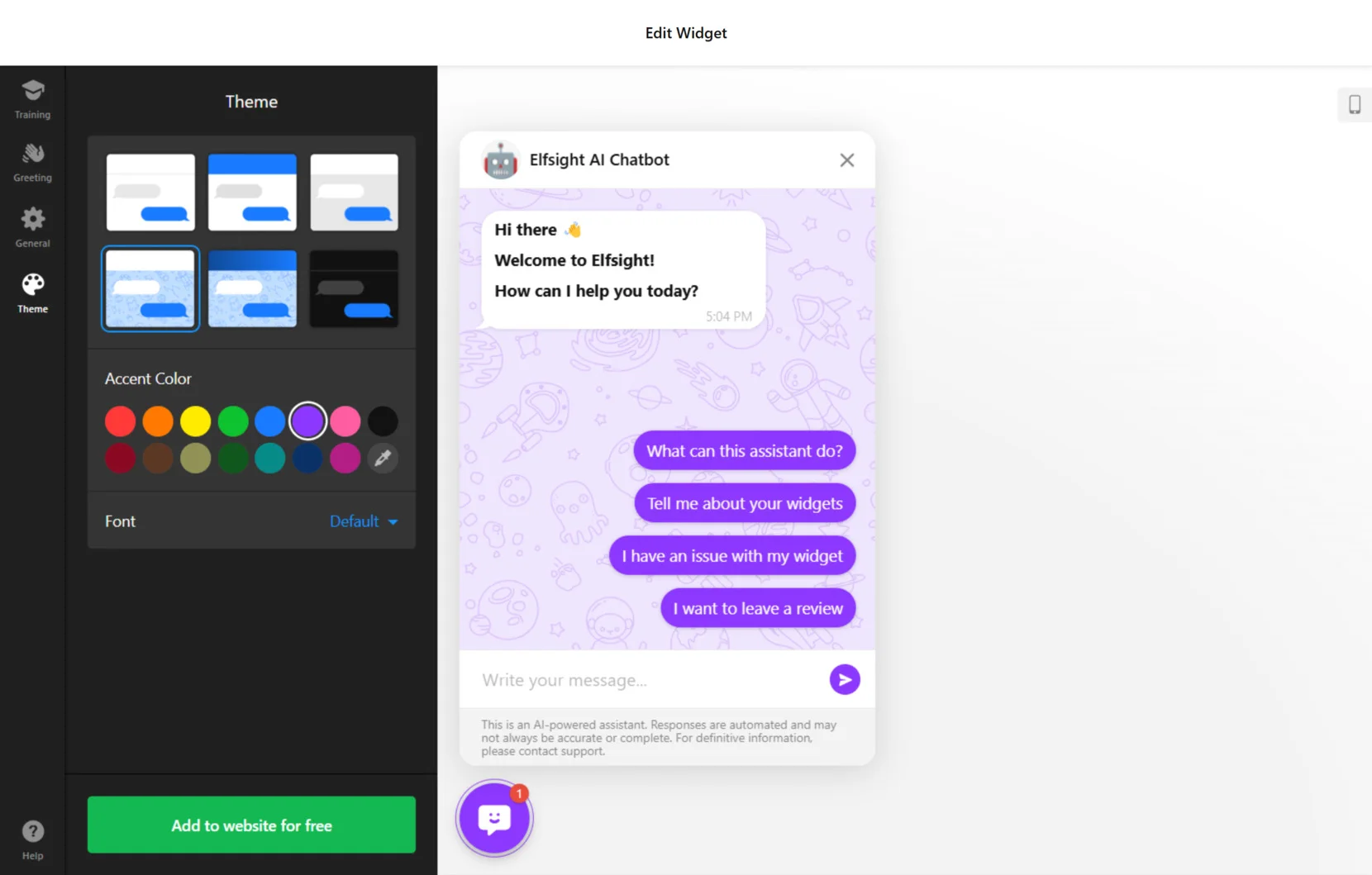
How to Set It Up:
- Launch the editor. Open the chatbot editor, pick one of the bot templates available and click on ‘Continue with this template’.
- Create your assistant. Enter the URL of your website or manually input your business details. Once you see a confirmation message that says, ‘Your assistant is ready’, click the ‘Add knowledge’ button to continue.
- Teach the AI chatbot. Add the information that your website chatbot needs to know. You can upload files in formats like PDF, TXT, DOCX, PPTX, JSON, HTML, or MD. Alternatively, you can write Q&A pairs manually or simply provide a text block.
- Customize the greeting. Set up a personalized welcome message for the chatbot and provide some quick reply options to make it easier for users to start a conversation with the chatbot.
- Adjust the widget settings. Input the name you want displayed for your assistant and upload a profile picture if you’d like. Customize the rest of the settings: chat bubble icon, footer information, etc.
- Pick the theme. Choose the color scheme, font, and accent colors that best match your website’s design to ensure the chatbot blends seamlessly with your site.
- Add the chatbot to your website. Once all modifications are complete, click on ‘Add to website for free’ and then ‘Publish.’ Copy the embed code provided and paste it into your website builder. Be sure to test the chatbot to ensure it functions correctly on your site.
Limitations:
- Less Control Over Deep Customization. Compared to API-based adjusting, Elfsight offers less flexibility in terms of deep customization of the chatbot’s behavior and performance.
- Limited Advanced Features. While it’s great for general chatbot use, it may not be suitable for complex tasks or integrations that require specialized workflows or data processing.
See the chatbot in action right now – build and train your assistant with our intuitive editor!
Fine-Tuning ChatGPT with OpenAI’s API
For those who need maximum flexibility and customization, OpenAI’s API offers the ability to refine ChatGPT using your own datasets. This method allows you to fully control how the model behaves, making it ideal for developers or businesses that need specialized functionality.
Fine-tuning with the API lets you train ChatGPT to better understand industry-specific language, respond with a specific tone, or improve performance on custom tasks. While this method provides the most control, it requires a deeper understanding of coding and API usage.
This approach is well-suited for applications where custom behavior and intricate functionality are needed, as it allows for more detailed model adjustments compared to easier, no-code solutions.
How the Process Works:
- Get API Access from OpenAI. Start by signing up for API access through OpenAI. You’ll need an API key to interact with OpenAI’s servers and use their fine-tuning tools.
- Format and Clean Your Training Data. Prepare your training data by cleaning and formatting it according to OpenAI’s guidelines. The data should be in a suitable format, such as JSONL (JSON Lines), with examples of input-output pairs that represent the type of conversation you want the model to learn.
- Upload and Optimize the Model Using OpenAI’s API Tools. Once your data is ready, upload it to OpenAI’s platform using their API. OpenAI provides specific endpoints to fine-tune the model, allowing you to configure training parameters, like the number of training steps and learning rate, for more control.
- Deploy the Chatbot in Your Application. After customizing, you can deploy the model within your application by integrating it via the API. This allows your chatbot to be used in any platform that can make API calls, such as websites, customer service tools, or mobile apps.
Limitations:
- Requires Programming Knowledge. Customizing ChatGPT using the API requires familiarity with coding and API interactions, making it more suitable for experienced developers.
- Associated Costs. Using OpenAI’s API comes with a pay-per-use pricing model, which can become costly depending on the amount of data and usage.
Best Practices for Training ChatGPT
When training ChatGPT, following best practices is crucial for achieving accurate, relevant, and high-quality results. Here are some key strategies:
📈 Use High-Quality, Well-Structured Training Data
The quality of the data you provide directly influences how well ChatGPT performs. Make sure your training data is clear, well-organized, and relevant to the tasks at hand. Using structured datasets like FAQs, product documentation, or industry-specific content will help the model understand the context and nuances of your domain. Clean and well-organized data improves the accuracy of responses and ensures a more efficient training process.
📅 Regularly Update Your Chatbot with New Data
To keep your chatbot relevant and useful, it’s important to refresh its training data regularly. This means adding new information, such as updated product details, industry trends, or user feedback. By maintaining an up-to-date dataset, you ensure that your chatbot continues to provide accurate, timely responses, staying aligned with changes in your business or market.
🔒 Ensure Compliance with Data Privacy Regulations
When working with customer data, always ensure compliance with data privacy regulations like GDPR, CCPA, or other applicable laws. It’s critical to anonymize or remove any personally identifiable information (PII) to protect user privacy. Make sure you are transparent with your users about how their data will be used for training and implement security measures to safeguard sensitive information.
🤔 Test and Refine Chatbot Responses
After training your chatbot with new data, always take time to test it in real-world scenarios. Simulate conversations to ensure it responds correctly and in a natural way. Refine its responses based on user interactions and feedback to improve accuracy. Iterating on your chatbot’s behavior ensures continuous improvement.
📱 Monitor Performance and Collect User Feedback
It’s essential to monitor your chatbot’s performance over time. Keep track of key metrics like response time, user satisfaction, and error rates. Collect feedback from users to identify areas for improvement and fine-tune the model. By continually assessing its performance, you can ensure your chatbot delivers consistent value and meets user expectations.
Real-World Use Cases
By training ChatGPT with tailored data, businesses and industries can unlock highly specialized AI applications that streamline operations, enhance customer experiences, and increase efficiency.
Here are several powerful ways to leverage a customized AI:
E-Commerce: Enhancing Customer Interactions
For e-commerce businesses, having an AI-powered chatbot trained on product catalogs, user reviews, and order histories can transform the shopping experience. By doing so, customers get quick, accurate answers about products, stock availability, and delivery times. A customized chatbot can even recommend products based on past purchases or browsing behavior, improving sales conversions.
Here are some benefits of using ChatGPT in e-commerce:
- Personalized product recommendations based on browsing history and preferences
- Instant query resolution about shipping, returns, and product availability
- Support for order tracking and cancellations without involving human agents
Customer Service: Streamlining Support Operations
AI chatbots trained with company-specific knowledge, FAQs, and product manuals can greatly reduce response times in customer service departments. Businesses can use these chatbots to handle basic inquiries, troubleshoot issues, or guide customers through solutions—freeing up human agents to focus on more complex concerns.
Key advantages of using ChatGPT for customer service include:
- 24/7 support availability ensuring customers are never left waiting
- Handling routine inquiries like account status or product details
- Reducing response time and improving user satisfaction with fast, accurate replies
Sales: Nurturing Leads and Boosting Conversions
A customized ChatGPT model can be a great sales assistant. Trained on your product’s specifications, pricing models, and common customer pain points, the chatbot can help qualify leads, answer product-related questions, and even suggest upsells or cross-sells. By delivering relevant and timely information, businesses can nurture leads more effectively and improve conversion rates.
When used in sales, ChatGPT can:
- Qualify leads by gathering relevant customer information and providing insights
- Suggest products based on customer data, enhancing upsell and cross-sell opportunities
- Handle objections and feedback in real-time, increasing conversion chances
Marketing: Personalizing Campaigns
When trained with customer behavior, preferences, and past interactions, ChatGPT can help marketers create more targeted campaigns. Whether it’s crafting personalized email responses or generating content for social media, AI models can help businesses connect with customers on a deeper level. ChatGPT’s ability to interpret user queries and respond appropriately means that it can be used to assist in content creation, messaging, and audience segmentation.
Here’s how ChatGPT benefits marketing efforts:
- Customizable email responses tailored to each customer’s profile and behavior
- Generating content for social media that resonates with target audiences
- Automating responses to promotions and inquiries, saving time and resources
SEO: Automating Content Creation
SEO specialists can harness ChatGPT to streamline content creation for websites, blogs, and more. By training the model on keywords, competitor content, and trending topics, it can generate high-quality, SEO-optimized content that ranks better in search engines. This can save time for content marketers, allowing them to focus on strategy and campaign management.
Here’s how ChatGPT can improve SEO:
- Generate blog posts and web copy optimized with the right keywords for better visibility
- Suggest SEO-friendly headlines, metadata, and tags based on search trends
- Create personalized SEO content for niche topics and audiences
Healthcare: AI-Powered Medical Assistance
ChatGPT trained on medical literature, diagnostic criteria, and treatment protocols can be a game-changer in healthcare. A custom-trained AI chatbot can provide basic health advice, symptom checking, medication reminders, and even first-aid instructions — empowering both patients and healthcare providers.
ChatGPT in healthcare offers:
- Medical information based on trusted, up-to-date sources
- Symptom checking with advice on next steps, based on current guidelines
- Medication reminders to improve patient compliance
Choosing the Right Training Method
When selecting the best method for training ChatGPT, your choice will depend on the complexity of your needs, your technical skills, and how much control you want over the chatbot’s behavior. Here’s a breakdown of the different options:
OpenAI’s Custom GPTs are great for those who need to get started with minimal effort and are looking for a fast, moderate-level customization solution. This option is ideal if you want a relatively easy-to-use interface and don’t need complete control over every aspect of the model.
Elfsight is a strong choice for companies looking to quickly set up a chatbot with little configuration needed. By uploading FAQs or relevant documents, you can tailor the chatbot’s responses to your specific needs and immediately start providing support on your site.
If you need total control over how ChatGPT responds and interacts, the OpenAI’s API is the best choice. It’s ideal for developers or teams with technical expertise who want to build a highly specialized AI, capable of handling complex scenarios and diverse queries.
Final Thoughts
Training ChatGPT on your own data is a powerful way to enhance its usefulness and accuracy for your specific needs. Each method of the discussed methods offers unique advantages. It’s important to weigh the trade-offs between ease of use, customization, and technical requirements when making your decision.
By carefully considering your business needs, technical capabilities, and available resources, you can effectively train ChatGPT to better serve your audience. With the right approach, you’ll be able to leverage the full potential of this AI tool, providing improved user experiences and more tailored responses that align with your goals.


